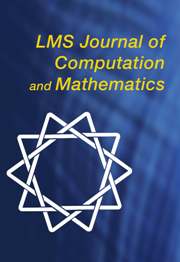Refine search
Actions for selected content:
2540 results in Computational Science
Index
-
- Book:
- A Practical Guide to Pseudospectral Methods
- Published online:
- 03 December 2009
- Print publication:
- 26 January 1996, pp 229-231
-
- Chapter
- Export citation
References
-
- Book:
- A Practical Guide to Pseudospectral Methods
- Published online:
- 03 December 2009
- Print publication:
- 26 January 1996, pp 217-228
-
- Chapter
- Export citation
4 - Key properties of PS approximations
-
- Book:
- A Practical Guide to Pseudospectral Methods
- Published online:
- 03 December 2009
- Print publication:
- 26 January 1996, pp 36-82
-
- Chapter
- Export citation
Contents
-
- Book:
- A Practical Guide to Pseudospectral Methods
- Published online:
- 03 December 2009
- Print publication:
- 26 January 1996, pp v-vi
-
- Chapter
- Export citation
APPENDIX 6 - THE SPORADIC SIMPLE GROUPS
-
- Book:
- From Error-Correcting Codes through Sphere Packings to Simple Groups
- Published by:
- Mathematical Association of America
- Published online:
- 05 June 2014
- Print publication:
- 01 June 1983, pp 211-216
-
- Chapter
- Export citation
CHAPTER 2 - FROM CODING TO SPHERE PACKING
-
- Book:
- From Error-Correcting Codes through Sphere Packings to Simple Groups
- Published by:
- Mathematical Association of America
- Published online:
- 05 June 2014
- Print publication:
- 01 June 1983, pp 61-108
-
- Chapter
- Export citation
PREFACE
-
- Book:
- From Error-Correcting Codes through Sphere Packings to Simple Groups
- Published by:
- Mathematical Association of America
- Published online:
- 05 June 2014
- Print publication:
- 01 June 1983, pp vii-xii
-
- Chapter
- Export citation
Contents
-
- Book:
- From Error-Correcting Codes through Sphere Packings to Simple Groups
- Published by:
- Mathematical Association of America
- Published online:
- 05 June 2014
- Print publication:
- 01 June 1983, pp xiii-xv
-
- Chapter
- Export citation
APPENDIX 5 - THE PROOF OF LEMMA 3.3
-
- Book:
- From Error-Correcting Codes through Sphere Packings to Simple Groups
- Published by:
- Mathematical Association of America
- Published online:
- 05 June 2014
- Print publication:
- 01 June 1983, pp 209-210
-
- Chapter
- Export citation
APPENDIX 3 - A CALCULATION OF THE NUMBER OF SPHERES WITH CENTERS IN Λ2 ADJACENT TO ONE, TWO, THREE AND FOUR ADJACENT SPHERES WITH CENTERS Λ2.
-
- Book:
- From Error-Correcting Codes through Sphere Packings to Simple Groups
- Published by:
- Mathematical Association of America
- Published online:
- 05 June 2014
- Print publication:
- 01 June 1983, pp 193-196
-
- Chapter
- Export citation
INDEX
-
- Book:
- From Error-Correcting Codes through Sphere Packings to Simple Groups
- Published by:
- Mathematical Association of America
- Published online:
- 05 June 2014
- Print publication:
- 01 June 1983, pp 225-228
-
- Chapter
- Export citation
CHAPTER 3 - FROM SPHERE PACKING TO NEW SIMPLE GROUPS
-
- Book:
- From Error-Correcting Codes through Sphere Packings to Simple Groups
- Published by:
- Mathematical Association of America
- Published online:
- 05 June 2014
- Print publication:
- 01 June 1983, pp 109-175
-
- Chapter
- Export citation
CHAPTER 1 - THE ORIGIN OF ERROR-CORRECTING CODES
-
- Book:
- From Error-Correcting Codes through Sphere Packings to Simple Groups
- Published by:
- Mathematical Association of America
- Published online:
- 05 June 2014
- Print publication:
- 01 June 1983, pp 1-60
-
- Chapter
- Export citation
APPENDIX 4 - THE MATHIEU GROUP M24 AND THE ORDER OF M22
-
- Book:
- From Error-Correcting Codes through Sphere Packings to Simple Groups
- Published by:
- Mathematical Association of America
- Published online:
- 05 June 2014
- Print publication:
- 01 June 1983, pp 197-208
-
- Chapter
- Export citation
APPENDIX 1 - DENSEST KNOWN SPHERE PACKINGS
-
- Book:
- From Error-Correcting Codes through Sphere Packings to Simple Groups
- Published by:
- Mathematical Association of America
- Published online:
- 05 June 2014
- Print publication:
- 01 June 1983, pp 176-186
-
- Chapter
- Export citation
Frontmatter
-
- Book:
- From Error-Correcting Codes through Sphere Packings to Simple Groups
- Published by:
- Mathematical Association of America
- Published online:
- 05 June 2014
- Print publication:
- 01 June 1983, pp i-vi
-
- Chapter
- Export citation
BIBLIOGRAPHY
-
- Book:
- From Error-Correcting Codes through Sphere Packings to Simple Groups
- Published by:
- Mathematical Association of America
- Published online:
- 05 June 2014
- Print publication:
- 01 June 1983, pp 217-224
-
- Chapter
- Export citation
APPENDIX 2 - FURTHER PROPERTIES OF THE (24,12) GOLAY CODE AND THE RELATED STEINER SYSTEM S(5, 8, 24)
-
- Book:
- From Error-Correcting Codes through Sphere Packings to Simple Groups
- Published by:
- Mathematical Association of America
- Published online:
- 05 June 2014
- Print publication:
- 01 June 1983, pp 187-192
-
- Chapter
- Export citation

LMS Journal of Computation and Mathematics
-
- Journal
-
- You have access: past subscription
